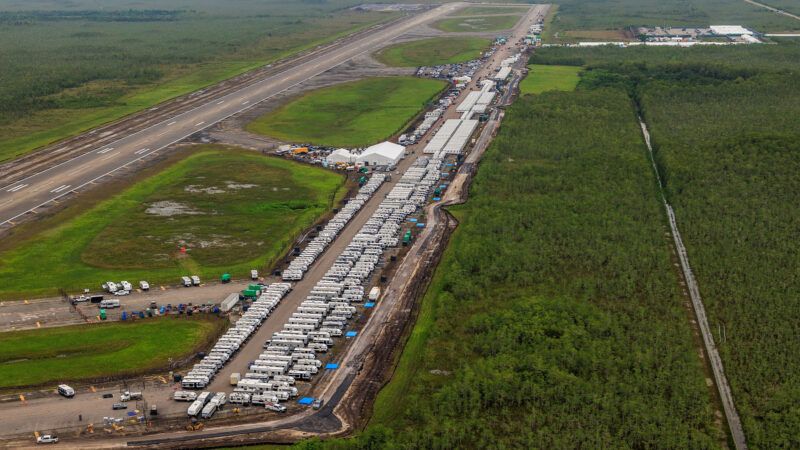The Original Alcatraz Closed for Costing Too Much. Alligator Alcatraz Should Too.
Florida’s elected officials should learn from the original facility that inspired the state’s newest immigrant detention center's name, and change course before it’s too late.

The newest state-run immigration detention center, Alligator Alcatraz, the brain-child of Florida Attorney General James Uthmeier, has been touted as an "efficient" and "low-cost opportunity" to house, process, and directly deport migrant detainees. But much like the original Alcatraz prison, elected officials should be wary of the rising cost that remote detention facilities have on taxpayers.
Alligator Alcatraz is located on a 30-square-mile parcel of land in the Everglades, chosen in part for its nearly 11,000-foot unused airstrip capable of directly accepting and deporting immigrant detainees. The land's remoteness was another selling point for the Florida officials. "They ain't going anywhere once they are here…because good luck getting to civilization," said Gov. Ron DeSantis (R) during a press conference on July 1, the day before the facility opened. "The security is amazing. Natural and otherwise," he continued, referring to the alligator- and python-laden perimeter surrounding the temporary tents used to house detainees.
It was the site's remoteness that inspired the facility's name, an homage to the original Alcatraz Federal Penitentiary located in the San Francisco Bay. DeSantis even quipped during an opening day tour of the Florida facility that Gov. Gavin Newsom (D) could potentially reopen Alcatraz as a state-run immigration detention center with the financial support of the Department of Homeland Security. But there are more similarities between Florida's Alligator Alcatraz and the notorious federal prison that DeSantis may want to consider.
Alcatraz, which ran as a federal prison from 1934 to 1963, was the product of a "collaborative effort of Attorney General Homer Cummings and Director of the Bureau of Prisons, Sanford Bates [to produce] a high-profile prison that represented the Justice Department's response to fears around public safety and organized crime," according to the National Parks Service. "A remote site was sought" specifically to "prohibit constant communication with the outside world." Despite San Francisco citizens' concerns (residents near Alligator Alcatraz oppose the facility), the experimental federal prison opened to house the country's worst criminals. During its time in operation, Alcatraz's inmate population averaged about 260 to 275, never reaching its 336 capacity limit.
The maximum-security facility eventually closed "because the institution was too expensive," according to the Federal Bureau of Prisons. Along with needed restoration and maintenance projects, the daily operational costs, coming in at $10.10 per capita in 1959 (or $111.96 adjusted for inflation), "were nearly three times more expensive…than any other Federal prison" because of the prison's physical isolation. The facility's isolation, although originally perceived as an asset, meant all supplies had to be shipped to Alcatraz, including food and "nearly one million gallons of water…each week."
Similarly, Alligator Alcatraz's remote and rudimentary Everglades location means that all supplies must be trucked in, including food, water, and generators for electricity. After only eight days of construction, the facility's temporary tents and chain-link cells now house over 700 migrants, with plans to hold up to 5,000. Detainees have already reported limited access to water and insufficient food.
Documents leaked shortly after opening revealed that the facility's cost may have already ballooned to over $600 million—$150 million more than the initially estimated $450 million per year—calling into question Uthmeier's claim that the detention facility would be "low-cost."
The cost of the state-run immigration detention center is being covered by Florida's taxpayers, with an opportunity for reimbursement from the Federal Emergency Management Agency's $625 million Shelter and Services Program fund. More money for similar projects may be on the way: the One Big Beautiful Bill Act set aside a $3.5 billion fund to reimburse states for, in part, the "temporary criminal detention of aliens," as part of a larger $45 billion appropriation to more than double the nation's current immigration detention capacity to 100,000 beds. The push comes as detention space has hindered President Donald Trump's overarching mass deportation goals.
Ultimately, taxpayers are on the hook for such exorbitant budgets, even while Americans are increasingly against Trump's crackdown. Costs aren't the only reason why Florida's state-run immigration detention center should close. But just as the original Alcatraz closed down for its ballooning costs, so too should Alligator Alcatraz.
